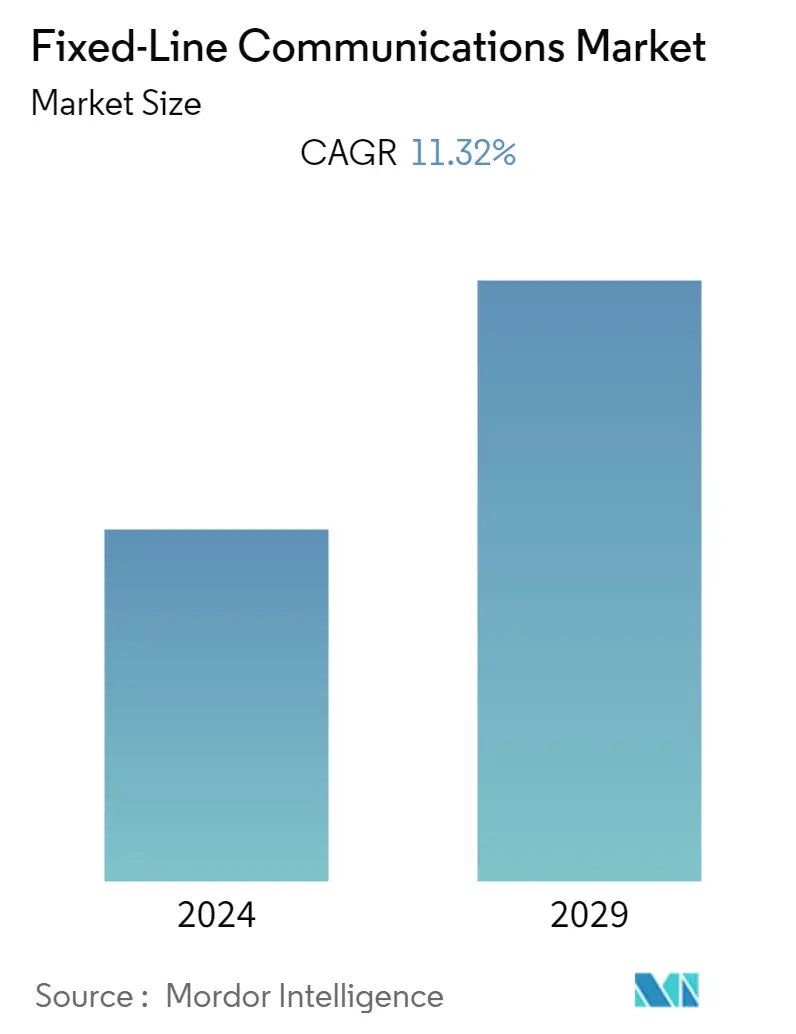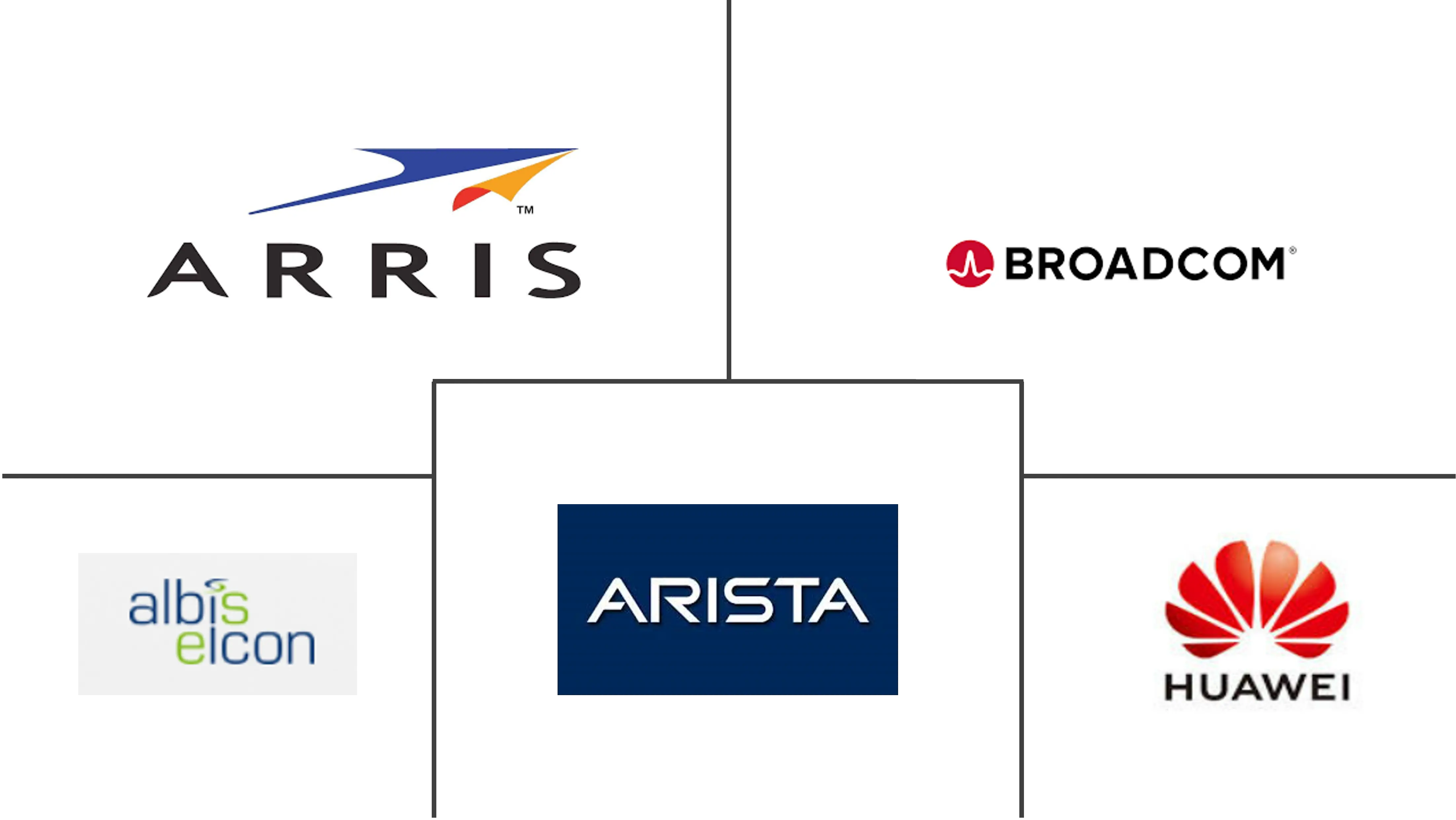Market Size of Fixed-Line Communications Industry

| Study Period | 2019 - 2029 |
| Base Year For Estimation | 2023 |
| CAGR | 11.32 % |
| Fastest Growing Market | Asia Pacific |
| Largest Market | Asia Pacific |
| Market Concentration | Low |
Major Players
*Disclaimer: Major Players sorted in no particular order |
Fixed-line Communications Market Analysis
The fixed-line communications market is expected to register a CAGR of over 11.32% during the forecast period.
- The trend for digitalization has also resulted in the emergence and shift toward purchasing set-top boxes (STBs) from cable television, allowing customers to enjoy a broader range of services at a relatively lower cost and enabling the providers to offer a better quality of services.
- The wired networks that provide fixed broadband and telephone services are generally referred to as fixed-line telecommunications. These modes of communication can be thought of as a cable connection to an end user, via which the user can connect to the Internet or make a phone call. Fixed data, often known as fixed broadband, refers to using a range of technologies for high-speed data transfer to a home or company. Examples of transmission methods are cable modem internet, digital subscriber line (DSL) internet, fiber optic cable, and other fixed broadband technology connections.
- The demand for faster Internet services is driving the market studied. Increasing Internet and broadband penetration and an increasing preference for high-definition (HD) channels and on-demand video services would likely boost market expansion. Fixed-line communications are highly relevant in small enterprises, homes, education institutes, and offices. Fixed-line telephone players are witnessing a boom in data service revenues. They are trying to provide 'triple play, a combination of play-broadband Internet, video, and voice, over an IP network, to consumers.
- Increasing demand for data centers is trending in the market with the advent of IoT, Big Data analytics, and cloud-based services. Network equipment plays a significant role in the operations of data centers. Additionally, there is an increasing demand for data centers from government agencies, large enterprises, and telecommunication organizations, driving the market studied.
- Nevertheless, the lack of training and development of technicians is a challenge for the growth of the market studied. According to Equinix, in this year's global tech trends survey, 74 percent of IT decision-makers view the shortage of personnel with the required skills as one of the main threats to the business.
- The COVID-19 pandemic provided a significant boost to connectivity. Digital technology and services enable individuals to have easy access to the Internet and use it regularly and effectively to better their lives in terms of work-from-home (WFH), online learning, online commerce, etc. This benefits people all over the world. This trend continues even post-pandemic owing to the increasing usage of data, an uptrend in 5G, and the rapid shift in working arrangements, helping businesses to stay in operation and communities connected in unprecedented conditions. These advancements drive the need for fixed-line communication equipment.
Fixed-line Communications Industry Segmentation
With the increasing digitization and the demand for data transmission, the fixed-line network has developed into a universal integrated services network. The merging of voice and data transmission via the fixed-line network opens up new possibilities. The adoption of 4G and 5G services is expected to augment the growth of the cable segment, as fixed-line communications are necessary to deliver such services.
The fixed-line communications market is segmented by product type (router, set-top box, and fiber optic cable), end user (residential and commercial), and geography.
The market sizes and forecasts are provided in terms of value (USD million) for all the above segments.
| By Product Type | |
| Routers | |
| Set-top Box (STB) | |
| Fiber-optic Cables |
| By End User | |
| Residential | |
| Commerical |
| Geography | |
| North America | |
| Europe | |
| Asia-Pacific | |
| Latin America | |
| Middle East & Africa |
Fixed-Line Communications Market Size Summary
The fixed-line communications market is poised for significant growth, driven by the increasing demand for high-speed internet services and the proliferation of digitalization. This sector encompasses wired networks that provide fixed broadband and telephone services, utilizing technologies such as fiber optic cables, DSL, and cable modem internet. The shift towards set-top boxes from traditional cable television has enabled providers to offer a wider range of services at lower costs, enhancing service quality. The market is further bolstered by the rising demand for data centers, fueled by IoT, Big Data analytics, and cloud-based services. Despite challenges such as a shortage of skilled technicians, the market continues to expand, supported by the ongoing digital transformation and the need for robust connectivity solutions.
In regions like Asia-Pacific, the fixed-line communications market is experiencing a surge due to the construction of data centers and the increasing adoption of fiber broadband services. The demand for high-speed internet and competitively priced fiber plans is driving the adoption of fixed-line services, with countries like China and India leading in broadband subscriptions. The market is characterized by intense competition and a fragmented landscape, with key players such as Arris International, Broadcom, and Arista Networks actively investing in fiber infrastructure and advanced networking solutions. Recent developments, including partnerships and acquisitions, aim to enhance broadband capabilities and extend connectivity options, further propelling the market's growth trajectory.
Fixed-Line Communications Market Size - Table of Contents
-
1. MARKET DYNAMICS
-
1.1 Market Overview
-
1.2 Market Drivers
-
1.2.1 Demand for Faster Internet Services by Public
-
1.2.2 Increasing Demand for Data Centers through Network Equipment
-
1.2.3 Growth of Fiber Optic Cable is Expected to Stimulate the Market Growth
-
-
1.3 Market Restraints
-
1.3.1 Lack of Training and Development of Technicians
-
-
1.4 Value Chain Analysis
-
1.5 Industry Attractiveness - Porter's Five Forces Analysis
-
1.5.1 Threat of New Entrants
-
1.5.2 Bargaining Power of Buyers/Consumers
-
1.5.3 Bargaining Power of Suppliers
-
1.5.4 Threat of Substitute Products
-
1.5.5 Intensity of Competitive Rivalry
-
-
1.6 Assessment of Impact of COVID-19 on the Market
-
-
2. MARKET SEGMENTATION
-
2.1 By Product Type
-
2.1.1 Routers
-
2.1.2 Set-top Box (STB)
-
2.1.3 Fiber-optic Cables
-
-
2.2 By End User
-
2.2.1 Residential
-
2.2.2 Commerical
-
-
2.3 Geography
-
2.3.1 North America
-
2.3.2 Europe
-
2.3.3 Asia-Pacific
-
2.3.4 Latin America
-
2.3.5 Middle East & Africa
-
-
Fixed-Line Communications Market Size FAQs
What is the current Fixed-Line Communications Market size?
The Fixed-Line Communications Market is projected to register a CAGR of 11.32% during the forecast period (2024-2029)
Who are the key players in Fixed-Line Communications Market?
Arris International PLC, Broadcom Inc., Arista Networks Inc., Huawei Technologies Co. Ltd and Albis Technologies AG are the major companies operating in the Fixed-Line Communications Market.

